Olly Walker, Essebeare Farm 2/3
What you do to encourage this biodiversity?
Over the past 3 years, we have planted over 12,000 hedge trees and recreated over 2,000 of new plantings. This forms 1805m of earth bank restoration, reconnecting habitats previously lost during the nation’s post war cropping drive. We have laid, fenced and cast up 1246m of overgrown rundown hedge banks and restocked them.
Over the next two years, we plan to restore a further 800 metres of lost earth bank and hedgerow. The total network of hedgerows added and managed on the farm will be well over 8km. This has been a massive focus!
We cut our meadows late in the season to make hay for cattle in winter, leaving wide wavy margins to the edge of fields and areas of the meadows uncut, which provides retreat and food resource for insects, especially butterflies and bumblebees. We have created a number of areas around the farm, such as, decaying wood piles and managed voids to provide food and space for birds, mammals and reptiles. The flail was banished from the farm’s hedgerow network in 2015 along with the shotgun. The hedgerows, described by one neighbour as “wonderfully blowsy” are now viewed as a well-stocked larder with nuts and berries - fruit galore!
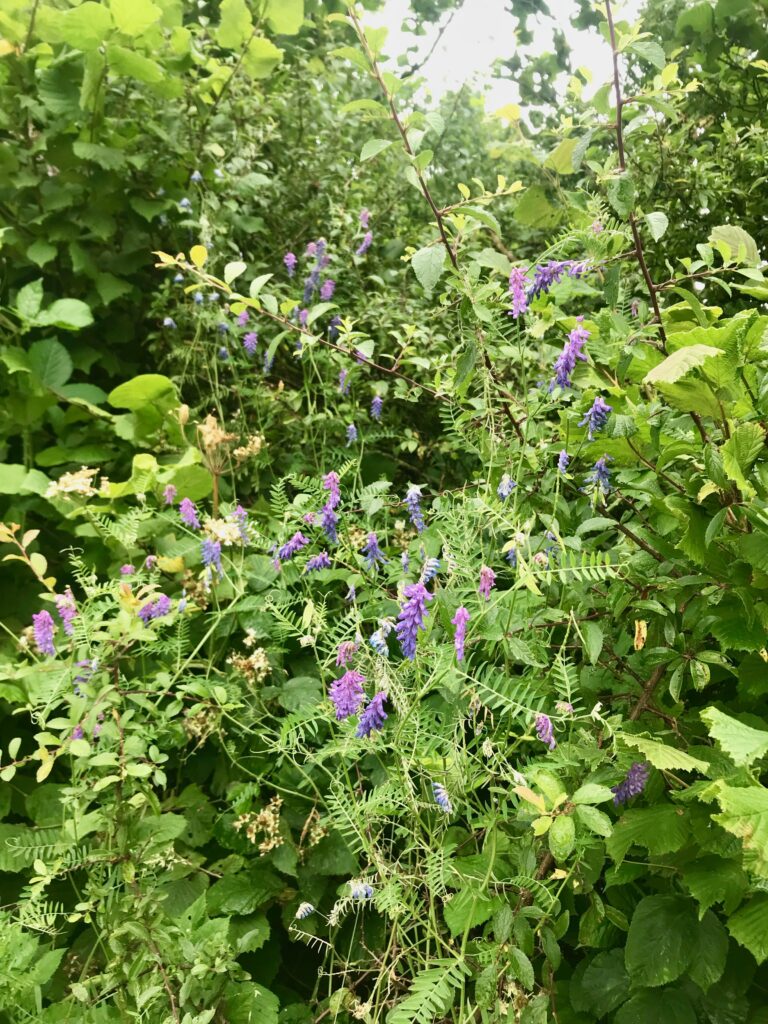
2-metre vertical vetch at Essebeare Farm (Olly Walker)
We have chosen a diverse and eclectic selection of trees for our new hedge plantings with a focus on feeding birds. These include the usual suspects but lots of rowan, spindle, wild pear, cherry and apple. Regular day visitors to the farm include sparrowhawks, kestrels, red kites and buzzards, whilst in the night we have tawny and barn owls. Overwintering bird mixture is also sown each spring. We have added into the mix a large proportion of giant sunflowers, which provides food for goldfinches and greenfinches as incoming pheasants steal food at ground level. I also counted 60 skylarks in late summer on a 5ha field in one afternoon!
On a recent school visit, we had a ‘snipe hunt’, reading Ted Hughes Plein Air to excite their minds, and 23 were counted in our wetland meadows. With around 50k breeding pairs in the UK and a recorded decline of 77% in breeders in recent years, it certainly feels like an honour to host them here in strength. We’re planning to spread the water further in these fields by some careful keyline contour ploughing to enrich the winterfeeding opportunities and species diversity. Thanks to a grant, we have a Logic Brush Seed Harvester, which we deploy during the high summer months to collect and spread retreating species-rich seed back onto our own and surrounding land.
Part of our winter management involves the ‘hoof and tooth’ method of tight grazing and subsequent generous over seeding in cold winter months. This may not be a long-term tool but essential in early management. We were one of the first farms in the UK to use the Kiwitech electric fencing and mobile water equipment in our cell grazing system. We purchased 1000m in 2015 because the farm had no fences and we had 600 sheep. This enabled us to quickly divide pastures and rotationally graze allowing paddocks a really good rest.
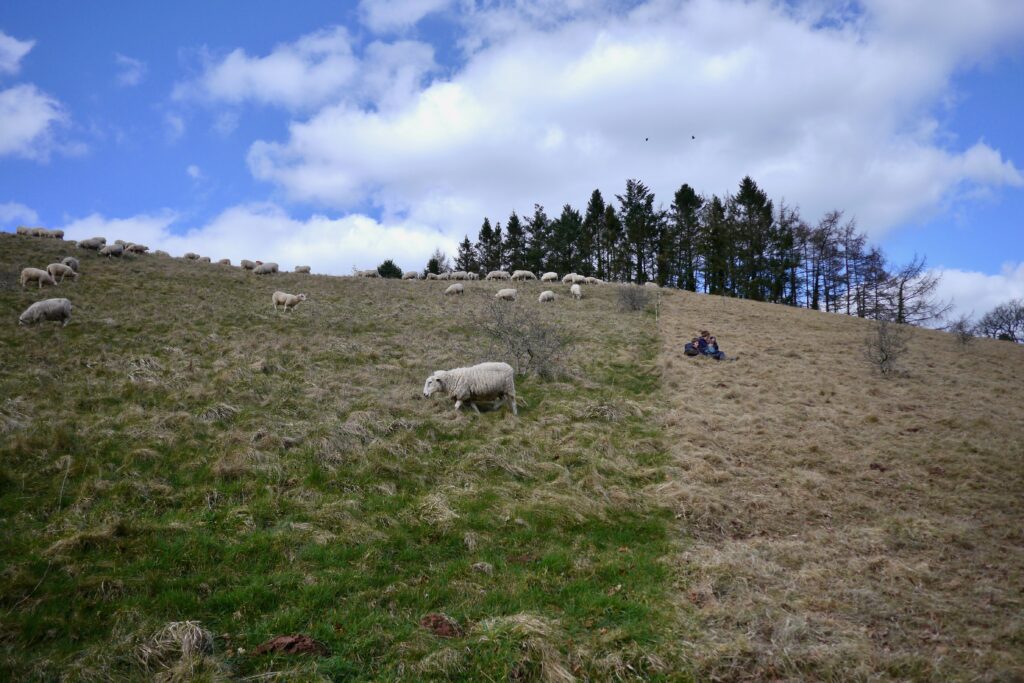
The result of fencing their sheep (Olly Walker)
How it is connected across the farm and beyond
We have recently formed a cluster of 3 landowners locally called Dashul Brake with the aim of increasing our biodiversity offering. This gets us all together round a table regularly, dreaming up the bigger picture for the future. We are extremely fortunate that the land adjacent to the farm valley is managed sympathetically and we look forward to working with all our neighbours in time.
Devon Wildlife Trust conducted a willow tit survey on the farm, surveying in total 70 tetrads within the county with birds present in only 11 of them. When a breeding pair were recorded in the nearby Sturcombe Valley, we started to get really excited. Being on the red (endangered) list, they require suitable deadwood available for nesting cavities, an open canopy and wet features like streams or meres. We are lucky to have all of these lying through a wet undisturbed valley.
We also love welcoming young people to the farm. Over the course of each year, we work closely with our local primary school, with as many as 100 children coming to the farm and learning aspects of organic agroecology - linking the life of the farm to our local community in step with the national curriculum. We hope to expand this approach in coming years by embracing the CSA model and crowdfunding for a dedicated green classroom. We’re consulting with Natural England and the Academy Trust of Schools locally to expand outreach and re-imagine the integration of the curriculum with a ‘Farm School’ model which is really exciting!
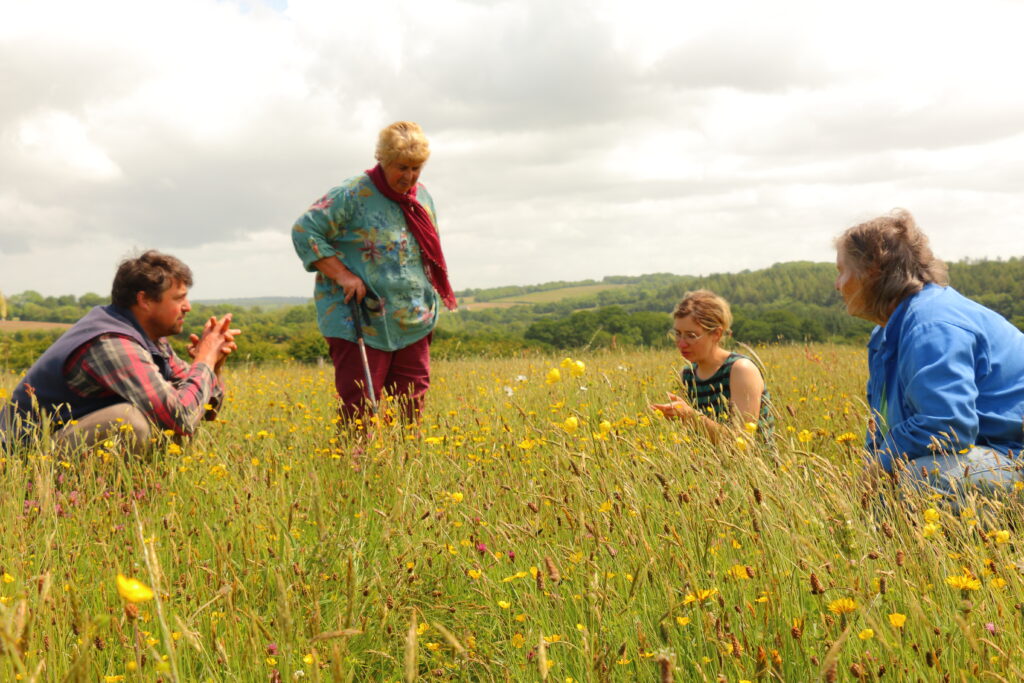
Olly, Val, Eti and Dorette on the farm's mob-grazed hay meadow (Martin Wright)
What are the benefits to the farm and is it increasing its climate and business resilience? If so, in what way?
The farm is an organism, each interconnected part supports the other in a circular motion. We have a deep respect for our soils. Our focus is on soil organic matter (SOM) to provide resilient ecosystem services – reinvigorating every strand of life beneath the fields. It is said that for every 1% increase in SOM, you will hold 20,000 gallons of available soil water per acre (USDA).
Healthy soils have a high-water holding capacity. The connection between soil and water is a major focus. We are employing diverse, species-rich herbal leys on long rotational grazing intervals as a necessary tool to repair the repetitive and exploitive synthetic cereal mono-cropping regime of the past. Soil testing and exploration revealed an organic matter of below 4%, and on a clay soil in the South West of England, we know we have the capacity to more than double this figure. The additions of organic matter, the living, the nearly dead and the dead, are all feeding the soil ecosystem and microbiome, creating rich food for the millions of worker worms. The banning of pesticide and persistent wormers in 2018 has been critical in kick-starting this soil regeneration thinking. On a practical note, we crutch our sheep twice a year and don’t use Permethrin-based fly treatments. We also moved away from a blanket, long-acting Clik repellent for lambs.
Soils that team with microbial life are a mystery to humans, and only a partial fraction is truly known about the microbiome. What we do know, is that our soils are a precious reservoir of biodiversity. We felt we could no longer use carcinogenic, broad-spectrum chemicals that kill indiscriminately on the farm. After all, our soils drive our business and need to be gently cultured. This interplay between bacteria, insects and fungi is a symbiotic superhighway that we trust and follow as it transports nutrients to feed our grasslands biodiversity above and below ground.
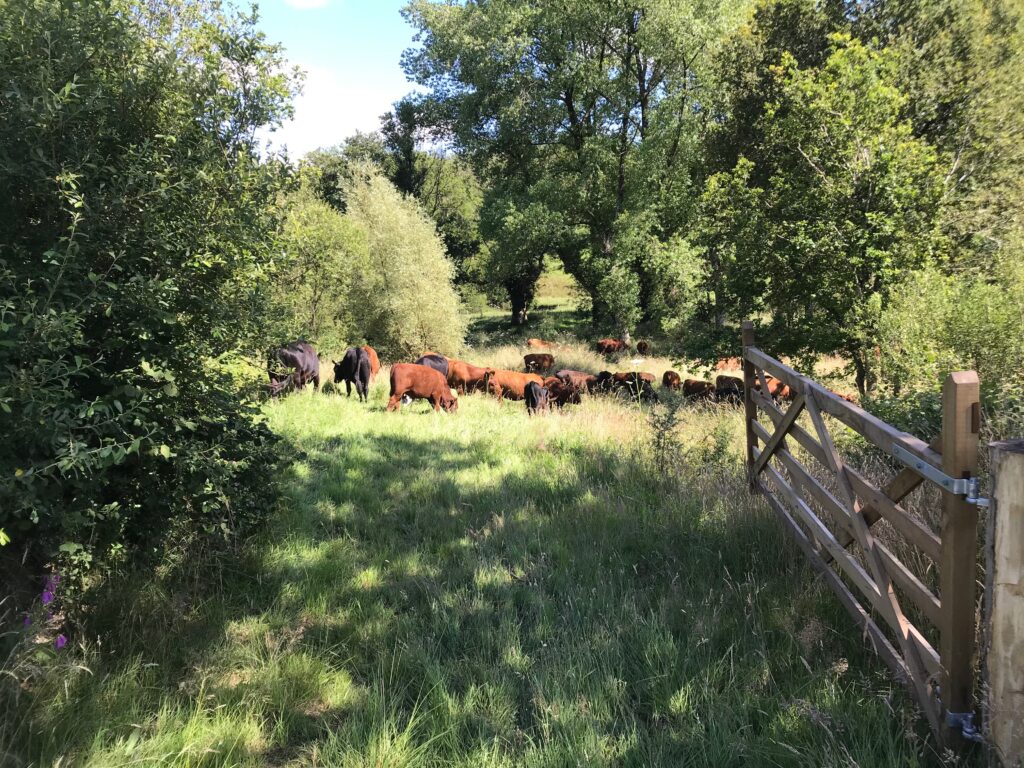
Essebeare Farm's PfL Certified herd (Olly Walker)
We don’t buy any straw for our 70 cattle, we haven’t in 7 years, partly because it’s frighteningly expensive and partly because you don’t really know what you’re letting yourself in for. Instead, we bed down on a wood chip and rush hay mix, locally known as ‘bullock hay’. There is a significant cost saving here and it’s an ethical choice because we know the science speaks of increasing bacterial activity within farm dung.
We focus on growing good forage as our source of on-farm protein, and we routinely analyse haylage for sheep to ensure the protein is 16% with a high D value, ensuring good intake by pregnant animals who may require it. This is achieved by adequate quantities of legumes and cutting at the right time and in optimal conditions, bailing and wrapping within 12hrs. We have begun experimenting with on-farm composting moving towards a Bokashi style, using the ingredients we have at our fingertips on the farm – ramial woodchip from hedgerow operations one key ingredient. The use of chipped brash from tree and hedge management activities has been a useful alternative to burning this material in the field. We want to keep the fertility on the farm and move fertility from the hedges and edges out into our soils. The introduction of active management to farm hedges and trees is benefiting their structure, function and viability, and ensuring that a full range of potential ecosystem services can be realised in the life of the hedge.
Deep-rooting herbal leys have continuingly proved themselves invaluable in recent years with slow dry cold starts to the grazing year and numerous heavy rainfall events – something we’ll increasingly see as our climate invariable warms up. We have worked hard to slow our grazing rotation down to the point that some pastures have up to 150 days of rest, and in the case of any conservation grazing in sensitive areas, this can even be a biannual event – almost a celebratory occasion to be relished. The rest period for soils is absolutely key to their resilience and our ability as farmers to rely on our pastures to carry stock and ride out the tricky months. The drought of 2018, the Beast from the East, the slow silent spring of 2021, followed by the wet cold May, showed challenging times to carry stock on heavy land. We are certainly following a low input, low carbon farming approach, and as we move towards net zero, we will audit our carbon footprint to better highlight improvements using the Farm Carbon Toolkit.
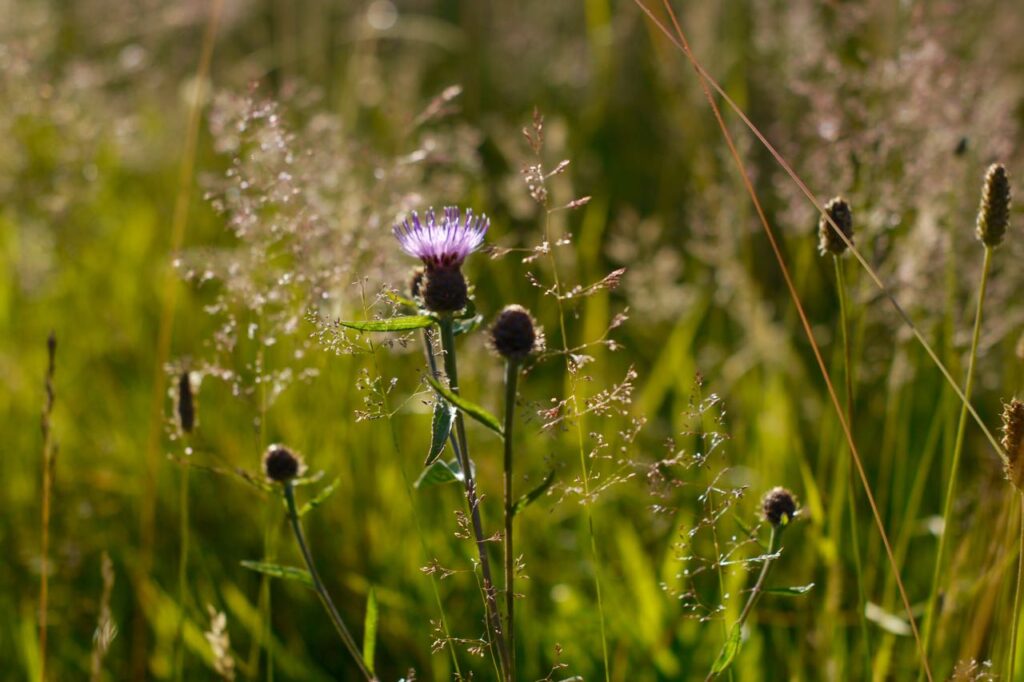
Diverse-rich pasture at Essebeare Farm (Olly Walker)



